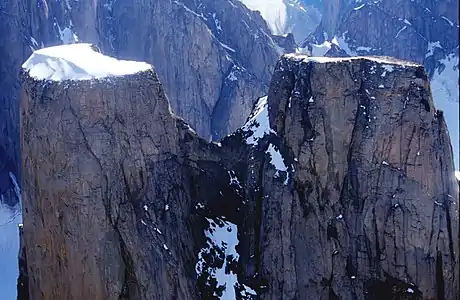| Mount Asgard | |
|---|---|
| Sivanitirutinguak | |
 Mount Asgard in July 2001 | |
| Highest point | |
| Elevation | 2,015 m (6,611 ft)[1] |
| Coordinates | 66°40′20″N 65°16′28″W / 66.67222°N 65.27444°W[1] |
| Geography | |
| Location | Nunavut, Canada |
| Parent range | Baffin Mountains |
| Topo map | NTS 26I11 Mount Asgard |
| Geology | |
| Mountain type | granite |
| Climbing | |
| First ascent | 1953 by J. Weber, J. Marmet, H. Röthlisberger |
| Easiest route | technical rock climb (Grade IV, YDS 5.8/5.9, A1) |
Mount Asgard (Inuktitut: ᓯᕙᓂᑎᕈᑎᖑᐊᒃ, Sivanitirutinguak[2][3][4]) is a twin peaked mountain with two flat-topped, cylindrical, rock towers, separated by a saddle. It is located in Auyuittuq National Park, on the Cumberland Peninsula of Baffin Island, Nunavut, Canada. The peak is named after Asgard, the realm of the Æsir (gods) in Norse mythology. Mount Asgard is perhaps the most famous of the Baffin Mountains.[5]
Climbing history

Asgard's slightly higher North Peak was first ascended in 1953 by J. Weber, J. Marmet, and Hans Röthlisberger, Swiss scientists on the Baffin Island Expedition of the Arctic Institute of North America, led by the Canadian, P. Baird.[6] Their route ascended the east side of the north peak, using a climbing traverse across snowfields and rock ribs, to reach the saddle between the two peaks, and thence to the top of the North Peak. The route is graded VI, 5.8/5.9 A1. It is still the most-travelled route and is the standard descent route for climbers making more difficult ascents on other faces.[7]

The South Peak was first climbed in 1971 by G. Lee, R. Wood, P. Clanky, J. Pavur, Y. Kamisawa and P. Koch. Since then, at least 13 routes have been put up on the two peaks, most involving highly technical free and aid climbing, with lengths varying from 800 to 1,200 m (2,600 to 3,900 ft). One of the most notable routes was put up in 1975 by Charlie Porter as a solo climb. This was "the first Baffin modern, multi-day, technical, big-wall climb", with 40 pitches rated at Grade VII, 5.10, A4 and it was followed by "a 10-day walk-out to the fjord-head without food". The fact that this was all done solo was "a remarkable achievement".[7]
In film
In 1976, Rick Sylvester, a stuntman and climber, performed a BASE jump, skiing off the mountain with a Union Jack parachute for the pre-title sequence of the James Bond film The Spy Who Loved Me although the setting was the Alps. The stunt team and film crew had reached the summit by helicopter.[8]
See also
References
- 1 2 "Mount Asgard". Bivouac.com. Retrieved 23 May 2009.
- ↑ Slaymaker, Olav; Catto, Norm (2020). Landscapes and Landforms of Eastern Canada. Springer Nature. p. 4. ISBN 978-3-030-35137-3.
- ↑ Favresse, Nico (16 September 2009). "Nicolas Favresse and Sean Villanueva O'Driscoll on Big Wall Free Climbing on Baffin Island - Patagonia". www.patagonia.com. Retrieved 3 July 2020.
- ↑ Mathisen, Herb (27 March 2017). "The Seven Wonders Of The Arctic Archipelago". Uphere Magazine. Retrieved 3 July 2020.
- ↑ "Baffin Island". Peakware.com. Archived from the original on 4 March 2016. Retrieved 2 November 2007.
- ↑ "Canadian/Swiss Baffin Island Expeditions, 1950 and 1953". Swiss Foundation for Alpine Research. Archived from the original on 11 August 2007. Retrieved 3 January 2008.
- 1 2 Scott, Doug (1998). "Mount Asgard". In Salkeld, Audrey (ed.). World Mountaineering. Bulfinch Press. ISBN 9780821225028.
- ↑ Lind, Benjamin (5 January 2013). "Stuntman Rick Sylvester's personal account of the Ski Jump in THE SPY WHO LOVED ME". The Bond Bulletin. Archived from the original on 31 January 2021. Retrieved 26 April 2021.